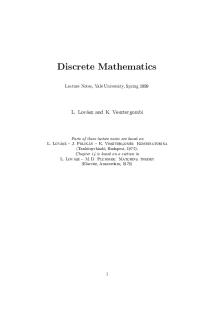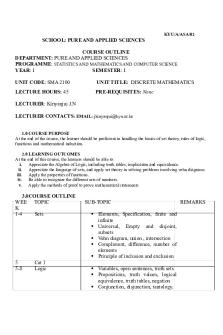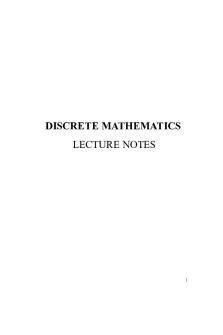Discrete Mathematics lesson 2 PDF

| Title | Discrete Mathematics lesson 2 |
|---|---|
| Author | WANJIKU GABRIEL MWAN PA105SEPT19 |
| Course | Probability ans statistics2 |
| Institution | Jomo Kenyatta University of Agriculture and Technology |
| Pages | 2 |
| File Size | 71.3 KB |
| File Type | |
| Total Downloads | 86 |
| Total Views | 181 |
Summary
notes...
Description
Power sets Power set The power set of a set S is the set of all subsets of S. Note that the power set contains S itself and the empty set because these are both subsets of S. For example, the power set of the set {1, 2, 3} is {{1, 2, 3}, {1, 2}, {1, 3}, {2, 3}, {1}, {2}, {3}, ∅}. The power set of a set S is usually written as P(S). The power set of a finite set with n elements has 2n elements. This relationship is one of the reasons for the terminology power set. For example, the set {1, 2, 3} contains three elements, and the power set shown above contains 23 = 8 elements. The power set of an infinite (either countable or uncountable) set is always uncountable. Moreover, the power set of a set is always strictly "bigger" than the original set in the sense that there is no way to pair every element of S with exactly one element of P(S). (There is never an onto map or surjection from S onto P(S).) Every partition of a set S is a subset of the powerset of S.
Cardinality Main article: Cardinality The cardinality | S | of a set S is "the number of members of S." For example, if B = {blue, white, red}, | B | = 3. There is a unique set with no members and zero cardinality, which is called the empty set (or the null set) and is denoted by the symbol ∅ (other notations are used; see empty set). For example, the set of all three-sided squares has zero members and thus is the empty set. Though it may seem trivial, the empty set, like the number zero, is important in mathematics; indeed, the existence of this set is one of the fundamental concepts of axiomatic set theory. Some sets have infinite cardinality. The set N of natural numbers, for instance, is infinite. Some infinite cardinalities are greater than others. For instance, the set of real numbers has greater cardinality than the set of natural numbers. However, it can be shown that the cardinality of (which is to say, the number of points on) a straight line is the same as the cardinality of any segment of that line, of the entire plane, and indeed of any finite-dimensional Euclidean space....
Similar Free PDFs

Discrete Mathematics lesson 2
- 2 Pages

Discrete mathematics worksheet 2
- 1 Pages

MAT 145 - Discrete Mathematics
- 139 Pages

Discrete Mathematics (CS6105)
- 108 Pages

BST Discrete Mathematics
- 3 Pages

Mcs-013 Discrete Mathematics
- 21 Pages

Discrete Mathematics MATH 1061 Final
- 14 Pages

Discrete Mathematics -5 Units Notes
- 190 Pages
Popular Institutions
- Tinajero National High School - Annex
- Politeknik Caltex Riau
- Yokohama City University
- SGT University
- University of Al-Qadisiyah
- Divine Word College of Vigan
- Techniek College Rotterdam
- Universidade de Santiago
- Universiti Teknologi MARA Cawangan Johor Kampus Pasir Gudang
- Poltekkes Kemenkes Yogyakarta
- Baguio City National High School
- Colegio san marcos
- preparatoria uno
- Centro de Bachillerato Tecnológico Industrial y de Servicios No. 107
- Dalian Maritime University
- Quang Trung Secondary School
- Colegio Tecnológico en Informática
- Corporación Regional de Educación Superior
- Grupo CEDVA
- Dar Al Uloom University
- Centro de Estudios Preuniversitarios de la Universidad Nacional de Ingeniería
- 上智大学
- Aakash International School, Nuna Majara
- San Felipe Neri Catholic School
- Kang Chiao International School - New Taipei City
- Misamis Occidental National High School
- Institución Educativa Escuela Normal Juan Ladrilleros
- Kolehiyo ng Pantukan
- Batanes State College
- Instituto Continental
- Sekolah Menengah Kejuruan Kesehatan Kaltara (Tarakan)
- Colegio de La Inmaculada Concepcion - Cebu







